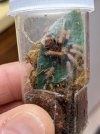- Messages
- 5,022
Nothing will have changed for European sellers selling direct to the US but CFTN are in N. Ireland which is no longer part of the European Union. The problem arises between the UK and Europe. You and Austin should be able to order direct from Europe.
I've contacted spiderworld.eu and they no longer ship to the US.


